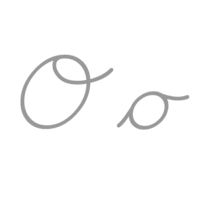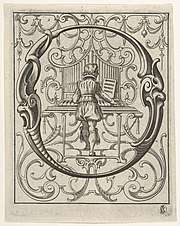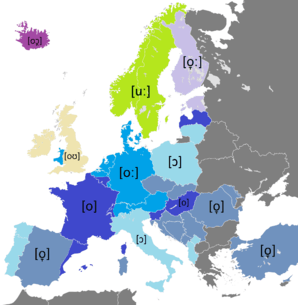O
O or o is the 15th letter in the ISO basic Latin alphabet and the fourth vowel letter in the modern English alphabet. Its name in English is o (pronounced /ˈoʊ/), plural oes.[1]
| O | |
|---|---|
| O o | |
| (See below) | |
 | |
| Usage | |
| Writing system | Latin script |
| Type | Alphabetic |
| Language of origin | Latin language |
| Phonetic usage | [o] [o̞] [ɔ] /oʊ/ [uː] [ʌ] [ɒ] [ø] [a] [ʕ] [w] [◌ʷ] [ʊ] |
| Unicode value | U+004F, U+006F |
| Alphabetical position | 15 |
| History | |
| Development | |
| Time period | ~-700 to present |
| Descendants | • Ö • ⱺ • Ø • Œ • Ɔ • Ơ • Ỏ • Ꝋ • ∅ • º • ℅ |
| Sisters | ᴥ Ƹ ʿ О Ю Ө ע ع ܥ ࠏ ዐ ࡘ ჺ Ո ո Օ օ ᱳ ᱜ ᱣ |
| Variations | (See below) |
| Other | |
| Other letters commonly used with | o(x) |
|
History

Its graphic form has remained fairly constant from Phoenician times until today. The name of the Phoenician letter was ʿeyn, meaning "eye", and indeed its shape originates simply as a drawing of a human eye (possibly inspired by the corresponding Egyptian hieroglyph, cf. Proto-Sinaitic script). Its original sound value was that of a consonant, probably [ʕ], the sound is represented by the cognate Arabic letter ع ʿayn.
The use of this Phoenician letter for a vowel sound is due to the early Greek alphabets, which adopted the letter as O "omicron" to represent the vowel /o/. The letter was adopted with this value in the Old Italic alphabets, including the early Latin alphabet. In Greek, a variation of the form later came to distinguish this long sound (Omega, meaning "large O") from the short o (Omicron, meaning "small o"). Greek omicron gave rise to the corresponding Cyrillic letter O and the early Italic letter to runic ᛟ.
Even alphabets that are not derived from Semitic tend to have similar forms to represent this sound; for example, the creators of the Afaka and Ol Chiki scripts, each invented in different parts of the world in the last century, both attributed their vowels for 'O' to the shape of the mouth when making this sound.
Use in writing systems
English
The letter ⟨o⟩ is the fourth most common letter in the English alphabet.[2] Like the other English vowel letters, it has associated "long" and "short" pronunciations. The "long" ⟨o⟩ as in boat is actually most often a diphthong /oʊ/ (realized dialectically anywhere from [o] to [əʊ]). In English there is also a "short" ⟨o⟩ as in fox, /ɒ/, which sounds slightly different in different dialects. In most dialects of British English, it is either an open-mid back rounded vowel [ɔ] or an open back rounded vowel [ɒ]; in American English, it is most commonly an unrounded back [ɑ] to a central vowel [a].
Common digraphs include ⟨oo⟩, which represents either /uː/ or /ʊ/; ⟨oi⟩ or ⟨oy⟩, which typically represents the diphthong /ɔɪ/, and ⟨ao⟩, ⟨oe⟩, and ⟨ou⟩ which represent a variety of pronunciations depending on context and etymology.
In other contexts, especially before a letter with a minim, ⟨o⟩ may represent the sound /ʌ/, as in 'son' or 'love'. It can also represent the semivowel /w/ as in choir or quinoa.
In English, the letter ⟨o⟩ in isolation before a noun, usually capitalized, marks the vocative case, as in the titles to O Canada or O Captain! My Captain! or certain verses of the Bible.[3]
Other languages

⟨o⟩ is commonly associated with the open-mid back rounded vowel [ɔ], mid back rounded vowel [o̞] or close-mid back rounded vowel [o] in many languages. Other languages use ⟨o⟩ for various values, usually back vowels which are at least partly open. Derived letters such as ⟨ö⟩ and ⟨ø⟩ have been created for the alphabets of some languages to distinguish values that were not present in Latin and Greek, particularly rounded front vowels.
Other systems
In the International Phonetic Alphabet, ⟨o⟩ represents the close-mid back rounded vowel.
Related characters
Descendants and related characters in the Latin alphabet
- Œ œ : Latin OE ligature
- O with diacritics: Ø ø Ǿ ǿ ᶱ[4] Ö ö Ȫ ȫ Ó ó Ò ò Ô ô Ố ố Ồ ồ Ổ ổ Ỗ ỗ Ộ ộ Ǒ ǒ Ő ő Ŏ ŏ Ȏ ȏ Ȯ ȯ Ȱ ȱ Ọ ọ Ɵ ɵ Ơ ơ Ớ ớ Ờ ờ Ỡ ỡ Ợ ợ Ở ở Ỏ ỏ Ō ō Ṓ ṓ Ṑ ṑ Õ õ Ȭ ȭ Ṍ ṍ Ṏ ṏ Ǫ ǫ Ȍ ȍ O̩ o̩ Ó̩ ó̩ Ò̩ ò̩ Ǭ ǭ
- Ꝍ ꝍ : O with loop was used in some medieval Nordic orthographies[5]
- ⱺ : Small o with low ring inside is used in the Swedish Dialect Alphabet[6]
- IPA-specific symbols related to O: ɔ
- Uralic Phonetic Alphabet-specific symbols related to O:[7]
- U+1D0F ᴏ LATIN LETTER SMALL CAPITAL O
- U+1D3C ᴼ MODIFIER LETTER CAPITAL O
- U+1D52 ᵒ MODIFIER LETTER SMALL O
- U+1D11 ᴑ LATIN SMALL LETTER SIDEWAYS O
- U+1D13 ᴓ LATIN SMALL LETTER SIDEWAYS O WITH STROKE
- U+1D16 ᴖ LATIN SMALL LETTER TOP HALF O
- U+1D17 ᴗ LATIN SMALL LETTER BOTTOM HALF O
- U+1D54 ᵔ MODIFIER LETTER SMALL TOP HALF O
- U+1D55 ᵕ MODIFIER LETTER SMALL BOTTOM HALF O
- Teuthonista phonetic transcription-specific symbols related to O:[8]
- U+AB3D ꬽ LATIN SMALL LETTER BLACKLETTER O
- U+AB3E ꬾ LATIN SMALL LETTER BLACKLETTER O WITH STROKE
- U+AB3F ꬿ LATIN SMALL LETTER OPEN O WITH STROKE
- U+AB43 ꭃ LATIN SMALL LETTER TURNED O OPEN-O
- U+AB44 ꭄ LATIN SMALL LETTER TURNED O OPEN-O WITH STROKE
- ₒ : Subscript small o is used in Indo-European studies[9]
Derived signs, symbols and abbreviations
- Ꝋ ꝋ : Forms of O were used for medieval scribal abbreviations[5]
- ∅ : empty set symbol[10]
- º : Masculine ordinal indicator
Computing codes
| Preview | O | o | O | o | ||||
|---|---|---|---|---|---|---|---|---|
| Unicode name | LATIN CAPITAL LETTER O | LATIN SMALL LETTER O | FULLWIDTH LATIN CAPITAL LETTER O | FULLWIDTH LATIN SMALL LETTER O | ||||
| Encodings | decimal | hex | decimal | hex | decimal | hex | decimal | hex |
| Unicode | 79 | U+004F | 111 | U+006F | 65327 | U+FF2F | 65359 | U+FF4F |
| UTF-8 | 79 | 4F | 111 | 6F | 239 188 175 | EF BC AF | 239 189 143 | EF BD 8F |
| Numeric character reference | O | O | o | o | O | O | o | o |
| EBCDIC family | 214 | D6 | 150 | 96 | ||||
| ASCII g1 | 79 | 4F | 111 | 6F | ||||
- 1 Also for encodings based on ASCII, including the DOS, Windows, ISO-8859 and Macintosh families of encodings.
Other representations
| NATO phonetic | Morse code |
| Oscar |
 |
|
 |
 |
| Signal flag | Flag semaphore | American manual alphabet (ASL fingerspelling) | Braille dots-135 Unified English Braille |
References
- "O" Oxford English Dictionary, 2nd edition (1989);Chambers-Happap, "oes" op. cit. Oes is the plural of the name of the letter. The plural of the letter itself is rendered Os, O's, os, o's.
- "Frequency Table". www.math.cornell.edu.
- "Quick search: "o lord"". Retrieved 2013-12-05.
- Constable, Peter (2004-04-19). "L2/04-132 Proposal to add additional phonetic characters to the UCS" (PDF).
- Everson, Michael; Baker, Peter; Emiliano, António; Grammel, Florian; Haugen, Odd Einar; Luft, Diana; Pedro, Susana; Schumacher, Gerd; Stötzner, Andreas (2006-01-30). "L2/06-027: Proposal to add Medievalist characters to the UCS" (PDF).
- Lemonen, Therese; Ruppel, Klaas; Kolehmainen, Erkki I.; Sandström, Caroline (2006-01-26). "L2/06-036: Proposal to encode characters for Ordbok över Finlands svenska folkmål in the UCS" (PDF).
- Everson, Michael; et al. (2002-03-20). "L2/02-141: Uralic Phonetic Alphabet characters for the UCS" (PDF).
- Everson, Michael; Dicklberger, Alois; Pentzlin, Karl; Wandl-Vogt, Eveline (2011-06-02). "L2/11-202: Revised proposal to encode "Teuthonista" phonetic characters in the UCS" (PDF).
- Anderson, Deborah; Everson, Michael (2004-06-07). "L2/04-191: Proposal to encode six Indo-Europeanist phonetic characters in the UCS" (PDF).
- "Earliest Uses of Symbols of Set Theory and Logic". jeff560.tripod.com.
External links
| Look up O or o in Wiktionary, the free dictionary. |

